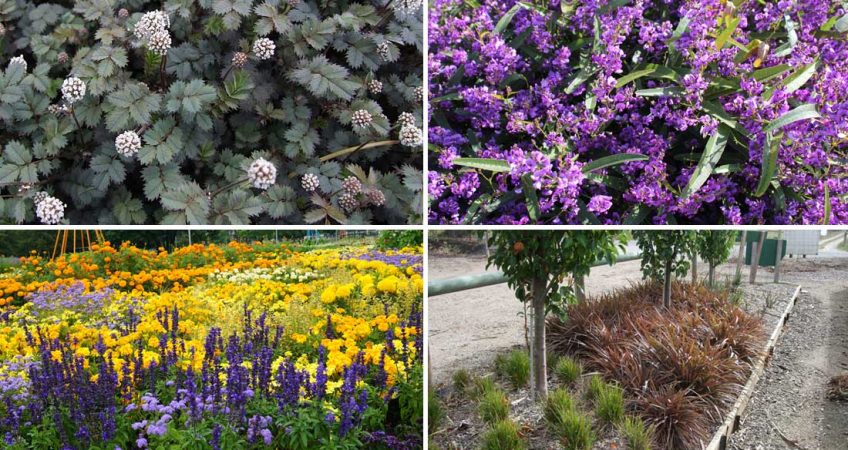Are you interested in ground covers for your garden landscape?
In this article, we’ll discuss why your garden needs ground covers, why you need them, and what some of the best groundcovering plants are that will thrive throughout New Zealand.
Understanding Ground Cover Plants
Ground cover plants are low-growing plants that spread across the ground, forming a dense layer of foliage. They can colonise open spaces, providing a continuous swathe of colour and texture.
- Ground cover plants are the bottom layer of a garden. They can add a lot more excitement than mulch can offer, with a lot of the same benefits. Image source: https://pxhere.com/en/photo/1609980
Types of Ground Cover Plants
Ground cover plants can be classified based on their growth patterns, foliage, and flowering habits. Some are prostrate woody shrubs, while others are herbaceous strappy grass-like plants. They can also be categorised by their flowering habits – some produce vibrant, eye-catching flowers, while others are grown primarily for their attractive foliage.
Benefits of Using Ground Cover Plants
Incorporating ground cover plants into your garden landscaping offers a host of benefits. Not only do they enhance the beauty of your garden, but they also contribute to its overall health and sustainability.
Weed Control
Ground cover plants form a dense mat of vegetation, blocking sunlight from reaching the soil surface. This inhibits the germination and growth of weed seeds, reducing the need for manual weeding or chemical herbicides.
Soil Erosion Prevention
Through their extensive root systems, ground cover plants help bind the soil together, reducing the risk of soil erosion. They protect the soil surface from the impact of rain, which can dislodge soil particles and wash them away.
Enhancing Garden Aesthetics
With their diverse forms, textures, and colours, ground cover plants can look a lot more exciting than simply laying mulch beneath the taller plants in your palette. They can fill bare areas, soften hard edges, and create visual interest, making your garden more attractive and inviting.
Biodiversity Support
Ground cover plants provide habitat for a variety of insects, birds, and other wildlife, welcoming biodiversity to your garden. Some ground cover species also produce flowers that attract pollinators, further enhancing biodiversity.
Their roots also provide carbon and nutrients for a wide range of soil organisms that in turn feed fauna higher on the food chain.
Popular Ground Cover Plants in New Zealand
New Zealand’s varied climate and rich biodiversity have given rise to a range of ground cover plants that are strikingly beautiful. These plants not only add aesthetic appeal to your garden but also contribute to the overall ecosystem’s health. Let’s take a look at some of the popular ground covers found in New Zealand.
- If you love native NZ plants, Acaena spp. are a great choice. Image source: https://commons.wikimedia.org/wiki/File:Acaena_magellanica_a1.jpg
Native NZ Ground Covers
Choosing native New Zealand plants for your garden comes with a host of benefits. Not only do they evoke a sense of national pride, but they also support local wildlife by providing food and habitat.
Here are six native New Zealand genera that are popular choices for ground cover in urban landscapes:
- Phormium: Also known as NZ flax, this genus includes several species suitable for ground cover. While some Phormium species and cultivars grow too tall to be used as a ground cover, others are small enough to serve this purpose effectively.
- Coprosma: This genus includes several evergreen shrubs ideal for ground cover, known for their glossy leaves that come in a range of colours.
- Hebe: Known for their beautiful flowers, some low-growing Hebe varieties make excellent ground cover plants, attracting bees and butterflies to your garden.
- Pimelea: This genus includes low-growing shrubs like Pimelea prostrata, commonly known as New Zealand daphne, which boasts tiny white flowers.
- Leptinella: Known for their fern-like foliage, Leptinella species like Leptinella dioica can form a dense carpet of greenery.
- Acaena: Species like Acaena novae-zealandiae are known for their attractive foliage and interesting seed heads.
Best Phormium Cultivars for Ground Cover
Here are two short New Zealand flaxes that are ideal for ground cover:
Sweet Mist Phormium
Sweet Mist Phormium (Phormium tenax ‘PHOS2’ PVR) is another compact variety that is perfectly suited for use as ground cover growing to 40cm high. This cultivar is cherished for its attractive green foliage, which provides a lush, dense cover when planted en masse.
It’s tolerant of various soil types and can also withstand both frost and moderately dry conditions. This resilience, coupled with its aesthetic appeal, makes ‘Sweet Mist’ a popular choice for ground cover in gardens across New Zealand.
Stripy Mist Phormium
The Stripy Mist Phormium (Phormium tenax ‘PHOS4’ PVR) cultivar serves as another outstanding choice for ground cover, with a mature height of 40cm. Known for its striking variegated foliage, this plant adds texture and visual interest to any garden setting. This flax is a robust plant that can endure various climatic conditions, including frost and even dry periods.
‘Stripy Mist’ Phormium is a low-maintenance plant requiring minimal care once established, thus proving an ideal choice for both novice and experienced gardeners. Its unique foliage makes it a standout choice for mass planting, offering a striking ground cover that enhances the overall aesthetics of your garden.
3. NZ flax are one of the best native ground covers around. Sweet Mist™ Phormium tenax ‘PHOS2’ PVR http://ozbreed.co.nz/plant-ranges/strappy-leaf-plants/sweet-mist-phormium/
Exotic Ground Covers
Incorporating exotic cultivars into your garden alongside native plants can bring an array of benefits. These plants, which have undergone selective breeding, exhibit resilience in the urban landscape.
It’s a misconception that exotics aren’t beneficial for native biodiversity. Many exotic species are indeed valuable resources for pollinators, contributing positively to local ecosystems.
Consider these exotic ground cover options to add diversity and visual appeal to your garden:
Baby Bliss Dianella
Baby Bliss Dianella (Dianella revoluta ‘DTN03’ PBR) is a hardy, compact perennial plant known for its deep blue flowers. Its sturdy nature and adaptability to various conditions make it an attractive choice for ground cover.
Evergreen Baby Lomandra
Evergreen Baby Lomandra (Lomandra longifolia ‘LM600’ PBR) is a dwarf variety forming dense tufts of fine foliage. It produces yellow flowers from September to October, offering a vibrant touch to your garden.
Isabella Liriope
Isabella Liriope (Liriope muscari ‘LIRF’ PBR) is a robust, low maintenance plant that forms a dense carpet of greenery. It features pink flowers, making it ideal for areas requiring ground coverage.
Double Gold Gazania
Double Gold Gazania (Gazania linearis ‘GT20’ PBR) is a vigorous plant known for its brilliant yellow flowers. Tolerant to drought and fond of full sun, it is a great choice for dry, sunny areas.
Meema Hardenbergia
Meema Hardenbergia (Hardenbergia violacea ‘HB1’ PBR) is a long-lived ground cover that displays vibrant purple pea flowers. Its adaptability to various soil types makes it a versatile addition to your garden.
Low Horizon Westringia
Low Horizon Westringia (Westringia fruticosa ‘WES06’ PBR) is a robust plant with white flowers. Known for its dense, ground-hugging habit, it requires minimal maintenance and is drought-tolerant.
Little Ruby Alternanthera
Little Ruby Alternanthera (Alternanthera dentata ‘LRU30’ PBR) is a compact plant with deep burgundy foliage. It forms a dense ground cover, making it a versatile choice for various garden applications.
4. This Aussie native looks great when it’s not in flower, but spectacular when it is. Meema™ Hardenbergia violacea ‘HB1’ PVR http://ozbreed.co.nz/plant-ranges/shrubs-and-ground-covers/meema-hardenbergia/
Garden Landscaping Ideas with Ground Cover Plants
Now let’s explore some simple backyard landscaping ideas that incorporate these plants, focusing particularly on groundcover landscaping.
Creating a Green Carpet
One of the simplest yet most effective ways to use ground cover plants is to create a lush green carpet.
Consider using Isabella Liriope as a lawn alternative. This low-growing, evergreen perennial forms dense clumps of arching, narrow leaves, making it ideal for creating a continuous carpet of green. It’s easy to grow, drought-tolerant, and can thrive in both sun and shade, making it a versatile choice for various garden settings.
Mow it once a year, or not at all.
To create your green carpet, start by preparing the soil well, removing any existing grass and weeds. Next, plant your Liriope at regular intervals, ensuring they’re close enough to form a dense cover as they grow, but far enough apart to allow for healthy growth. Maintain your green carpet by watering regularly, especially during dry spells, and trim back the foliage once a year to encourage fresh growth.
Bordering Garden Paths
Ground cover plants can also be used effectively to border garden paths, adding depth and interest to your outdoor space. These plants soften the edges of the path, creating a more natural and inviting look.
For path borders, consider using Phormiums or low-growing Westringia hedges. Both these plants are hardy, drought-tolerant, and provide year-round interest, making them excellent choices for path borders.
When planting, ensure the plants are spaced correctly, allowing enough room for growth but close enough to form a continuous border.
Designing Rock Gardens
Ground cover plants can also play a role in rock gardens. They help soften the harshness of the rocks and add colour and texture to the landscape. Lomandras, with their cascading foliage, are excellent choices for this function.
When designing your rock garden, consider the size and shape of your rocks and choose plants that complement them. Plant your Lomandras in between the rocks, allowing their foliage to cascade over the them, softening their appearance.
Conclusion
Whether you’re layering different plant types, creating a lush green carpet, bordering a garden path, or designing a rock garden, ground covering plants can add depth, interest, and colour to your outdoor space. So why not experiment with ground cover plants in your own garden and see what you can create? The possibilities are endless.

